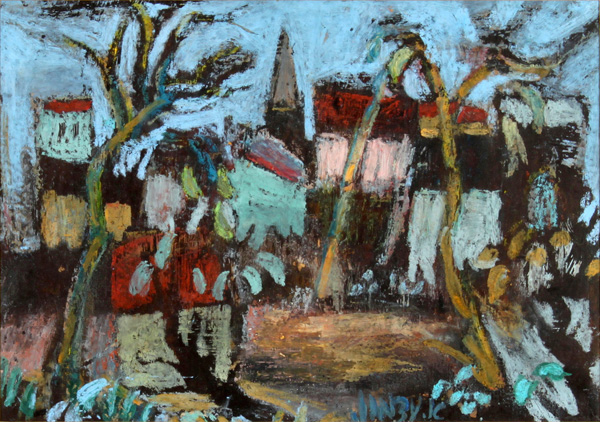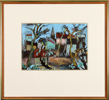<
Back to Paintings
< Previous Next >
Abraham Atzmon (Avraham Azmon) - Pastel Drawing - Blue Landscape
אברהם עצמון - פסטל - נוף
Avraham Azmon (1917-2008) was born in Israel to a religious Yemenite family in a rather poor, hard working class neighborhood of Tel-Aviv, on the border between Tel-Aviv and Jaffa, called "Mahane Yoseph" (the camp of Joseph). Azmon's father was a Hazzan whose function is to lead, in singing and reciting, the prayers in the synagogue. Azmon's formal education started with four years of a Yemenite Talmud-Torah. Then he continued in the Tachkemoni elementary school in Tel-Aviv, which he finished around 1932.
After finishing school he found work as a locksmith and did not follow his artistic tendencies which were discovered around this time. His first period of serious painting was between the years 1934-1938 - in that period he acquired experience in making frames for pictures - the profession of which he made his living for the rest of his life. In the years 1937-38, he managed a small art gallery in Tel-Aviv - Yad Oman (the hand of the artist) where he got acquainted with some of the young painters in Tel-Aviv of those days.
Azmon was a self-taught painter and his resume does not include any formal studies of art. His first subjects were drawn from his immediate surroundings. For several years he painted his childhood neighborhood Mahane Yoseph and its surroundings. Later on, his reservoir of subjects expanded to other areas including still-life, and his style became more abstract and fantastic like this beautiful exciting pastel landscape painting.

Blue Landscape by Abraham Atzmon
![]()
הצייר אברהם עצמון (1917-2008) נולד בתל-אביב בשכונת מחנה יוסף מדרום לכרם התימנים, שאחר כך מוזגה עם שכונת מחנה יהודה הסמוכה ונקראת כיום שכונת שבזי. עצמון (עצאמי), בן למשפחת מסורתית של יוצאי תימן שעלו ארצה בתחילת המאה ה-20, למד ב-"תלמוד תורה" של העדה התימנית ברחוב יבנאל ומשם עבר ללמוד בבית הספר העממי-דתי "תחכמוני" ברחוב לילנבלום.
הנטייה והכשרון לציור נתגלו באברהם כבר בבית הספר העממי, אך בהנחיית אביו שהיה חזן ואיש ספר, החל לעבוד כמסגר-פחח, מקצוע מבוקש באותה תקופה. כדרך לשמר את אהבתו לאמנות עסק אברהם גם בהתקנת מסגרות לתמונות ובארגון תערוכות לציירים, בהם ותיקים ומפורסמים כדוד הנדלר, ישראל פלדי ומרדכי לבנון שהיו אז חלק מסצנת האמנות המשגשגת של שנות ה-30 בתל-אביב. לקראת סוף שנות השלושים ניהל אברהם גלריה קטנה, הרבה לצייר ונראה היה ששלהבת התאווה לציור נצתה בו ביתר עוז אך תנאי החיים וטרדות פרנסה לא איפשרו לו להתמסר לאמנותו. מרבית התמונות שצייר בתקופה זו אבדו וחבל.
בתקופת מלחמת השחרור - 1948 - כאשר איזור התפר שבין יפו לתל-אביב הפך לאיזור קרבות, עברה משפחת עצמון להתגורר בבית דו-קומתי בשכונת רסקו בחולון שם, בקומה הראשונה, הקים אברהם בית המלאכה למסגרות לתמונות ורכש לעצמו שם כממסגר מומחה בעל טעם אמנותי משובח. אברהם עצמון יחד עם בנו יחיעם הובילו למעשה את אומנות המיסגור בארץ, ייצרו פרופילים למסגרות לתמונות מצופים בעלי זהב וכסף דקיקים ואפשרו לאמני ישראל של שנות ה-60 וה-70 ליהנות מרמת מיסגור באיכות אירופאית. מראה די שכיח היה לראות את גדולי הציירים ובעלי הגלריות בארץ עולים לרגל לבית שליד רחוב גאולים עם בדים ומסגרות בכדי להתייעץ מהי הדרך הנכונה להציג את עבודותיהם.
ציור הנוף של אברהם עצמון שלפנינו הוא פורקן לדחף הפנימי שמילא את ישותו הצנועה - צבעוניות שנראית לכאורה מאופקת - פני התמונה מפורקים ליחידות קטנות, מעין משבצות, וצבעי הפסטל כביכול לא דרמטיים - ולמרות זאת ציור הנוף הזה אינו רגוע ופסטורלי. להפך. הוא טעון במתח, בחיספוס וקשיות והדרמה פורצת בסערה לא מרוסנת אל פני השטח - זוהי דוגמה מצוינת ליכולות האקספרסיביות העצמתיות של הצייר הנחבא אל המסגרות - אברהם עצמון.
נושא הציור הוא עיר או אולי שכונה בעיר. אמנם אי-אפשר לקבוע בודאות האם המבנים ממשיכים להשתרע אל מעבר לשדה הראיה שהתמונה מעמידה לרשותינו, או שהם מוכלים כולם בתוך גבולותיו אבל ברור שהעניין המרכזי בציור הזה הוא דוקא המקום שבו בחר הצייר למקם אותנו, הצופים, ביחס לעיר. הוא פותח לנו חלון בחזית התמונה, ואנו מתבוננים בבתים דרך ענפי שיחים ועצים. קל מאוד לדמיין שאנחנו נמצאים בקצה של חורשה קטנה. לא זו בלבד שנקודת המבט שהקצה לנו הצייר מותירה את שאלת גודלה האמיתי של העיר פתוחה, אלא שהיא גם מייצרת באופן טבעי, תרתי משמע, דרמה ועניין. ענפי העצים המשתרגים וכתמי הצבע של הפרחים, מתעמתים עם הרקע הסטטי והבלתי חדיר של קירות הבניינים, ועם הקשיחות הגיאומטרית של הצריחים והמבנים. הצמחיה משתוללת, מעוותת את הפרספקטיבה, מקצרת מרחקים, וגורמת לטישטוש גבולות והטעיות אופטיות. נוסף על כך, עצמון מגייס לטובת העצמת האפקט הדרמטי גם את צבע הרקע של השמיים. הוא בוחר בגוון לבן של כחול שמנמיך את השמיים אל האדמה. האור מזכיר בצבעיו ובאיכויותיו אור ירח בליל ירח מלא אם כי לא מצאתי ירח בשדה הראיה של התמונה, וגם עוצמת האור אינם מתאימה לסצינה לילית. כך או כך, הציור לופת אותך ואינו מרפה. העצים טעוני החיוּת והאור הירחי גורמים לי לתהות האם העיר שנשקפת מבעדם אכן מעוגנת בקרקע המציאות או שמקומה יכירנה רק בממלכות החלום והזיכרון.
Biography of the painter Avraham Atzmon - ביוגרפיה של הצייר אברהם עצמון

Avraham Atzmon signature on the lower right corner of the drawing.
Unlike most of the other ethnic groups of Jews from Arab countries, the Yemenite Jews came to the land of Israel in several waves of immigration many years before the foundation of the state. In fact, the first wave dates back to the early days of the Zionist movement itself. Moreover, their main motivation in coming was pure idealistic Zionism, colored by biblical innocence. In the land of Israel they settled in their own villages and neighborhoods, and didn't mix much with the Jews of eastern European origin. This may explain the very slow penetration of their strong cultural traditions into the emerging Israeli culture.
The Yemenite Jewish tradition includes poetry, music making and goldsmith work, but not painting or sculpting. This is of no surprise since, as is well-known, the Torah forbids the making of paintings and sculptures, and unlike the case of the European Jews, the Yemenite Jews could not acquire the taste and knowledge which are required for practicing art, from their Islamic neighbors. With this background, one cannot avoid a feel of awe and admiration towards Avraham Azmon remarkable personal story which led him to become a recognized and a highly appreciated artist.
Avraham Azmon first two single exhibitions were held in Rina gallery in Jerusalem (1962) and in the Dugith Art Gallery in Tel-Aviv (1967) where his beautiful paintings were first introduced to the art collectors community in Tel Aviv. In the 70s he had 2 exhibitions in the Modern Art Gallery in Old Yafo and also participated in general exhibitions of Israeli painters abroad, including the USA, Australia and Nepal.
Size of painting (without frame):
9.4" x 6.7" - 24 cm x 17 cm - 9.4 in x 6.7
in
Type of frame: Wood - the drawing is under glass, framed in a passe-partout
Painting technique: Pastel and watercolor on Paper
Origin: Israel
Date: 1970
Signature: "א.עצמון"- signed in Hebrew by the artist on the lower
right corner of the drawing.
Price: $750
References:
Avraham Azmon
- Biography of a Delicate Self-Taught Painter
Item: P1023/PAI089 - Avraham Atzmon Pastel Landscape
© Dan Levy - Art Pane Home of Original Paintings and Sculptures
< Back to Paintings
< Previous Next >

